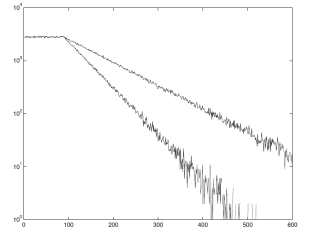This is an old revision of the document!
T3R Antibunching - Slow Decay
Q.: How can we avoid decay at very long time delay (up to 5us)?
In this show-case the external preconditions are:
- detectors: perkin elmer SPCMAQR14
- 700 nm SP filter in front of one of the apds
- sample: diamond nanocrystals (100 nm), we are measuring the antibunching of the NV centers emission
- laser wavelength: 532 nm, cw
- T3R Measurement with PicoHarp Software
A.: The decay can be caused by blinking of the nanodiamonds.
A decay caused by correlation statistics
On top of an eventual blinking you will have a decay caused by correlation statistics.
This happens because you correlate the first arriving photon against a photon at the longer time,
which will be an increasingly unlikely event because the earliest stop photons always win and the experiment restarts.
I attached a simulation.
You will I need the raw data
The timescale is in ns. The plateau is the dead-time. The decay slope depends on the count rate.
You can zoom into your data and you will see roughly the same behavior - linear decay after the dead-time, which than of course is overshadowed by the background.
The way to avoid this is is to calculate the total correlation. This is not a start-stop correlation but the correlation of every photon against every photon.
It can be done measuring in T2 mode and then correlating using the SymPhoTime Software (http://www.picoquant.com/products/sw_mt/sw_mt.htm).
For a trial you will I need the raw data - a pt2 file containing all the photon data - not just the correlated curve. You can record this using the button I highlighted in the attached screenshot.

